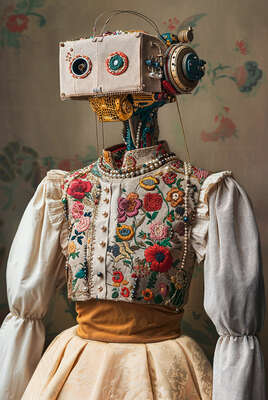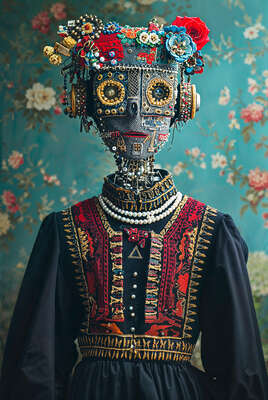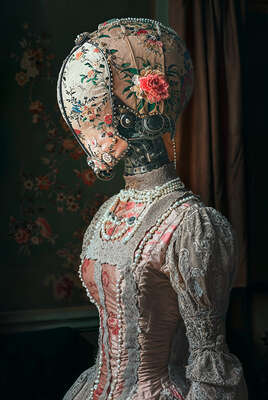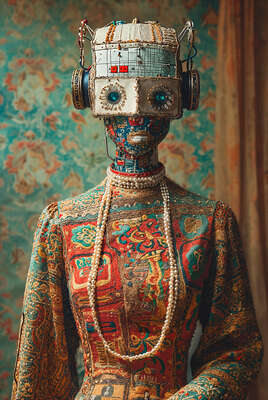David Szauder's group of works "Folkloric Robots" is a profound reflection on the interplay of tradition and innovation. From the title to the motif, his work creates a symphony of contrasts that is as striking as it is harmonious. In doing so, he subtly breaks with the viewer's expectations and raises relevant social questions.
Szauder takes up the contrast between technology and humanity, which also plays a central role in pop culture - for example in futuristic film classics like Metropolis. His avant-garde approach is also reminiscent of contemporary masterpieces such as the Oscar-winning science-fantasy film Poor Things, a reinterpretation of Frankenstein's monster with a feminist perspective.
The subjects of man and technology, artificiality and authenticity, life and creation are reflected in Szauder's works. He transfers these ideas not only visually, but also conceptually into the artistic context: by using artificial intelligence and modern image editing programs, he illustrates the tension between past and future, tradition and progress, technology and craftsmanship, and science and sensuality.
The Hungarian artist works as a lecturer at the Moholy-Nagy University of Art in Budapest and has exhibited his pieces in renowned institutions such as the Pompidou Center in Paris and the Leonardo Museum in Milan. His work has also graced the cover of the Washington Post Magazine and his reflections on contemporary art have been published by Oxford University Press.
The vision for the "Folkloric Robots" was born in Barcelona, where he was inspired by the interaction of history and modernity that characterizes the city. “Folklore“ can generally be understood as the intangible cultural heritage of an ethnic or religious community whose traditions have been passed down through generations. If one compares the concept of folklore with the concept of the robot, they show parallels in that they are forms of information processing - one based on sensors and programming, the other one on sensuality and communality. The “Folkloric Robots” thus combine the contrasting worlds of myths of the past and visions of the future. This interweaving is literally visible, as the robots, a symbol of the future of humanity, are dressed in traditional costumes woven from fabrics that are precisely designed down to the individual threads. The traditional embroideries that adorn the robots are far more than mere decoration; they are an essential part of their identity and reflect the importance of cultural heritage in a rapidly modernizing world. Each robot highlights a distinct cultural aspect, from communal celebrations to forms of individual expression.
Through the fusion of traditional and futuristic elements, Szauder's works raise relevant questions about social norms and developments. The portraits, most of which are classically depicted as bust portraits, play with traditional patterns of painting and modern motifs. As individual portraits, they irritate in a charming way by bringing together the theme of androids with the question of individuality. The robots wear dresses - another experiment with expectation that triggers a reflection on our cultural imprint: Is there an irritating moment in the combination of technology and traditional femininity, and if so, why? Szauder's meticulously crafted portraits artfully question learned imagery and social patterns.
The contrast between state-of-the-art technology and traditional craftsmanship, cultural heritage and social progress, delicate fabric and robust machine, programming and individuality, function and emotion creates an avant-garde field of tension with an irresistibly bizarre appeal.


















